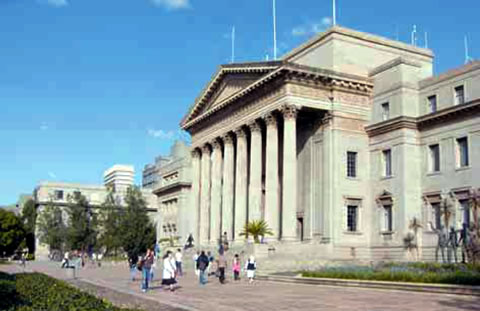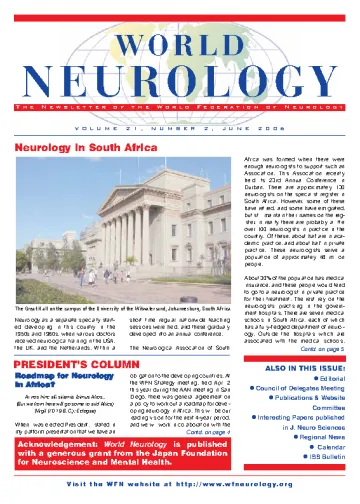Original article by Dr. Kevin Rosman, WFN National Delegate South Africa, Johannesburg, published 25 July 2006 in World Neurology Vol21 No. 2
Neurology as a separate specialty started developing in this country in the 1950s and 1960s when various doctors received neurological training in the USA, the UK, and the Netherlands. Within a short time, regular nationwide teaching sessions were held, and these gradually developed into an annual conference.
The Neurological Association of South Africa was formed when there were enough neurologists to support such an Association. This Association recently held its 23rd Annual Conference in Durban. There are approximately 130 neurologists on the specialist register in South Africa. However, some of these have retired, and some have emigrated, but still maintain their names on the register. In reality, there are probably a little over 100 neurologists in practice in the country. Of these, about half are in academic practice and about half in private practice. These neurologists serve a population of approximately 48 million people.
About 30% of the population has medical insurance, and these people would tend to go to a neurologist in private practice for their treatment. The rest rely on the neurologists practising in the government hospitals. There are seven medical schools in South Africa, each of which has a fully-fledged department of neurology. Outside the hospitals which are associated with the medical schools, there are no neurologists whatsoever practising in any other public hospitals.
 |
The Great Hall on the campus of the University of the Witwatersrand, Johannesburg, South Africa |
Neurology in the public hospitals is very strongly influenced by the presence of AIDS. On any given day, in any given academic department in a public hospital, more than 50% of the admissions are likely to be associated with an AIDS-related disease. This has put an enormous burden on the treating doctors. The spectrum of neurological disease in the private sector is probably very similar to that in any Western country. However, the pattern of neurological diseases seen in the public sector probably more accurately reflects a mixture of tropical neurology, with a good dose of nutritional problems, as well as the rest of the neurological spectrum.
While all the academic hospitals have a CT scan, only recently has the first MRI scanner been installed in one of the academic hospitals. In all other instances, a rationing process occurs to allow some, but not all of the patients to have an MRI scan. At the end of 2005, the very first PET scanner was installed in a private hospital in Johannesburg. Neurological training in South Africa consists of a minimum of four years in a registrar post in an academic hospital. One of the four years may be in a related discipline, such as internal medicine or psychiatry. An exit examination is required in order to register with the Health Professions Council as a neurologist. This examination is divided into two parts, which are usually written at about a two-year interval. The first part focuses on basic sciences, and the second part relates to clinical neurology. These examinations are generally taken in the course of the training period. The examination most commonly taken is run under the auspices of the College of Neurology.
Some of the universities also offer a Masters degree in Neurology, which is run on a similar basis, but under the auspices of the relevant university. A dissertation may or may not be required in this instance. Only after achieving one of these two examinations, and having the training time accepted by the Health Professions Council, is an individual entitled to register as a neurologist, and to practice as such. Once registered, one may not practice any form of medicine other than neurology. While most newly qualified neurologists would prefer to remain in the academic setting for at least a number of years, a severe limitation on the number of specialists' posts causes many young neurologists to have to enter private practice before they would have preferred.
Very few, if any, posts exist in the non-academic public hospitals for neurologists. Generally, neurologists in private practice will tend to work in solus practices, with only a few having one or two partners. Most neurologists will own their own EEG machines, which will be run by an EEG technician. Usually, some type of call rota is arranged with colleagues practising nearby to allow for some time off. ■








